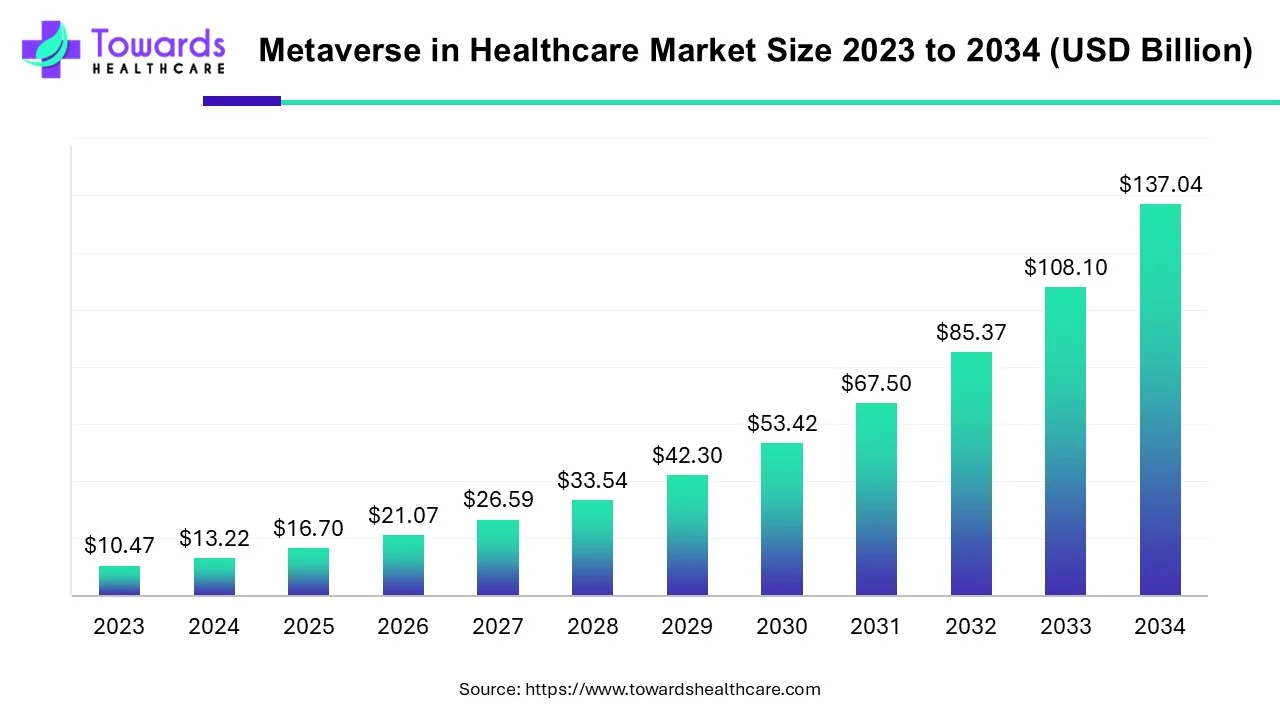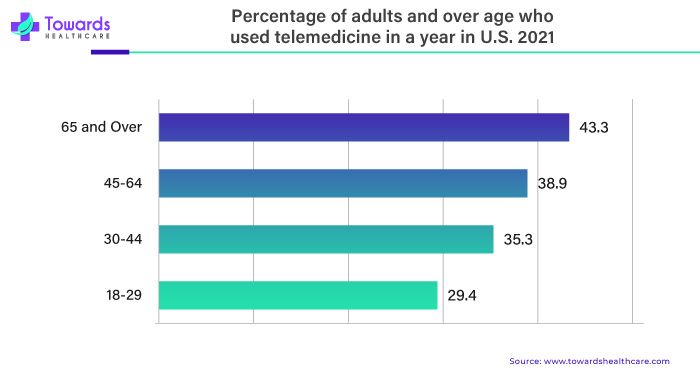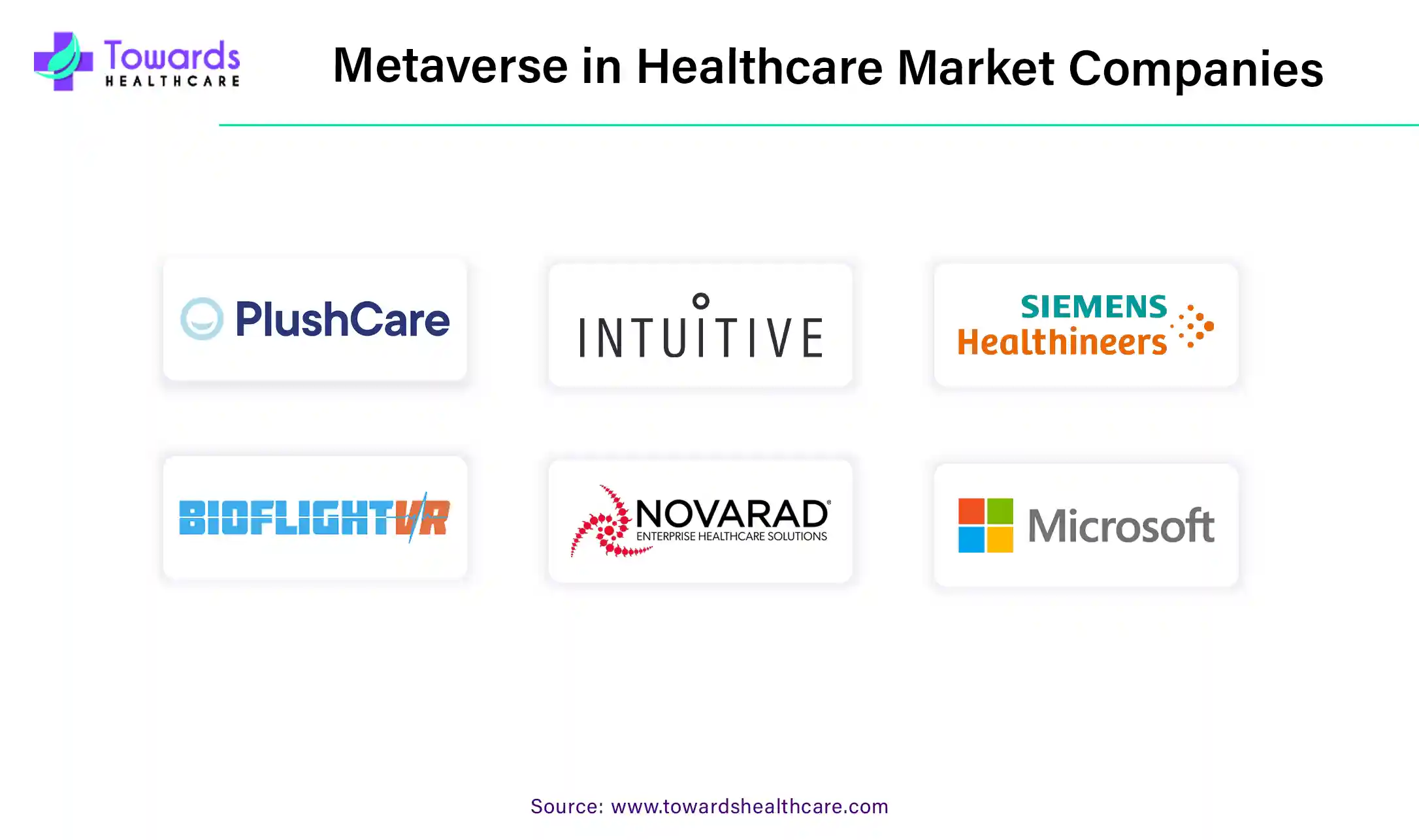December 2025

The global metaverse in healthcare market is projected to reach USD 137.04 billion by 2034, growing from USD 16.7 billion in 2025, at a CAGR of 26.3% during the forecast period from 2025 to 2034, as a result of the growing healthcare infrastructure and technology advancements.

According to a recent metaverse poll, 66% of US corporate executives actively engage with the metaverse, and 82% expect it to be an aspect of "business as usual" within the next three years or shorter.
The metaverse is a platform for integrating the virtual and physical worlds. It allows people to interact with their models in a virtual reality, augmented reality, mixed reality, blockchain, digital twins, and artificial intelligence (AI) environment that is enhanced by virtually limitless data. The metaverse, which was first introduced as a social media entertainment platform, has the potential to significantly influence clinical practice and public health in the healthcare industry. As a team of researchers from academia, business, medicine, and regulation, we recognize particular chances for metaverse methods in healthcare. A metaverse of "medical technology and AI" (MeTAI) can help develop, prototype, assess, regulate, translate, and improve AI-based medical practice, notably Medical Imaging-guided diagnosis and therapy.
The ongoing development of metaverse-compatible technologies has also demonstrated the potential to completely transform this approach to clinical skills training. Students may have rare opportunities to practice history and physical skills, complex clinical cases, and significant ethical issues in a low-stakes, safe environment through the simulation of virtual environments. The effectiveness of virtual reality (VR) in teaching clinical skills competency to nurses has also been extensively studied. These studies suggest a remarkable potential for supplementing medical education, which warrants further investigation to develop a more thorough understanding of its implications.
Applications of virtual reality education may be explored as early as the 1st year of medical school when preclinical education covers basic subjects like anatomy, radiology, and more. Universities have been known to use AR and VR technology as extra teaching aids for medical anatomy, with encouraging results. Additionally, more research has been done on applying these tools in radiology education.
Integration of AI in the metaverse in healthcare is driving the growth of the market as AI improves digital realms by allowing intelligent avatars, powering the creation of content, and increasing personalized user experiences. This incorporation of AI in medical care is pivotal in managing the massive amounts of data generated in the metaverse, which confirms efficient processing and adaptation to consumer interactions. Patients analyze their health through the application of AI-based systems in the metaverse, and it supports them to keep track of their health instead of taking any appointments with a physician or visiting any hospital physically, which drives the growth of the market.
| Sr. No | Stream | Application | Examples |
| 1. | Radiology | A rise in the number of images viewed and altered watch more detailed moving images to help with illness or injury diagnosis | Image Restoration |
| 2. | Medicine/Psychiatry | Blockchain-based patient data security for telemedicine consultations | The FDA approved endeavorRX, a virtual reality game developed by Akili Interactive, as the first prescription-strength video game to treat attention-deficit/hyperactivity disorder (ADHD) in children |
| 3. | Surgery/Facial Surgery | Surgeons will have real-time access to the patient's vital signs, pictures, medical records, and any additional data | Arbrea labs working on face simulation tools |
| 4. | Medical Wearable | Respiration Monitoring | In COVID-19, Chronic Pulmonary Obstructive Disorder |
The metaverse’s expansion in healthcare reflects a growing recognition of its potential to revolutionize the industry, fostering collaboration and advancing medical practice on a global scale. As this trend continues, the metaverse is poised to play a pivotal role in shaping the future Healthcare delivery and innovation landscape.
Metaverse technologies offer numerous benefits for health care companies, including:
Health care metaverse startups attracted $2.2 billion in private funding during the assessed period, with investment growing at an annual rate of nearly 30%. This funding spans all stages of the patient journey, including patient engagement, care delivery, and payment, as well as the development of enabling technologies and support functions such as medical personnel, health care data, analytics, and operations.
Most use cases (70% of companies, 90% of funding) involve XR and are relevant to health care providers and payers. Key areas of XR application include:
AR and VR infrastructure, medical-procedure assistance, and medical training receive the majority of the funding. Major providers and payers are already using many of these applications, including training, mental health therapy, physical therapy, vision diagnostics, and AR-supported surgery.
While about 30% of companies are developing blockchain technologies, they receive only 10% of the total funding, indicating that this technology is still in its early stages with smaller funding rounds. Blockchain applications in health care include:
These applications are relevant to both payers and providers, providing a secure and efficient way to manage health care data and transactions.
A Healthcare delivery model known as telemedicine uses telecommunications technology to provide medical services and consultations from a distance. Healthcare providers can diagnose and treat patients in real-time through video conferencing, mobile applications, and remote monitoring devices. This eliminates the need for in-person visits and allows patients to receive treatment from the comfort of their own homes. Because of its adaptability, telemedicine can be used for various medical services, such as mental health, primary care, and specialist consultations.

The growing application of digital twins in healthcare has aided in the widespread adoption of telemedicine. The system combined an agent-based discrete event simulator with a virtual reality environment. It also included a platform that displayed predictive analytics during the simulation run.
For Instance,
One method that has shown promise for changing the way urological consultations are provided is telemedicine. It has produced satisfactory results for patients and clinicians while drastically cutting costs and time. The convergence of telemedicine and the metaverse represent a groundbreaking synergy, offering innovative solutions and immersive experiences for both healthcare providers and patients. This dynamic integration facilitates enhanced communication, diagnosis and treatment options, fostering a more accessible and inclusive healthcare ecosystem.
The Metaverse is becoming increasingly crucial in urological surgery, including surgical training, thanks to recent technological advancements. The idea of image-guided intervention and surgery has been discussed in great detail, and the use of 3D-printed phantoms has confirmed the effectiveness of AR visualization for image-guided surgery. AR technology enables surgeons to obtain patient information without using their hands by superimposing a 3D virtual model onto a patient's body. Additionally, real-time visualization of the tumour's characteristics and 3D anatomy—unique to each patient—is made possible by combining augmented reality technology and the patient's anatomy, enhancing the safety and effectiveness of surgical procedures.
Robotic procedures have firmly established themselves in the ever-evolving landscape of urological surgeries, particularly in ureteral reconstruction. The integration of advance technologies, such as fluorescence-guided surgery and 3D imaging, is rapidly transforming the field of urology. These innovations provide surgeons powerful tools, enhancing their comprehension of patient-specific anatomy. Pediatric urology has witnessed a surge in the adoption of Augmented Reality (AR) devices, offering a more lifelike grasp of normal and abnormal anatomies. This shift allows for real-time insights, enabling tailored treatments.
For Instance,
The global market's increasing interest in the metaverse within healthcare amplifies this transformative wave. The growing emphasis on metaverse technologies signifies a broader trend towards advancing healthcare practices, fostering enhanced collaboration and training, and ultimately, improving patient care on a global scale.
The burgeoning potential of the metaverse in healthcare needs to be improved by the substantial costs associated with high-end technologies.
In May 2022, The National Institute of Health’s article explores how financial barriers pose challenges to adopting and advancing metaverse solutions in the healthcare market. Addressing the financial barriers associated with high technology costs is crucial for unlocking the full potential of the metaverse in healthcare.
| Financial Barriers to Entry | The intricate technologies required for an immersive healthcare metaverse experience demand substantial financial investments. From cutting-edge virtual reality (VR) systems to sophisticated augmented reality (AR) applications, the expenses can be prohibitive, limiting the number of healthcare institutions able to embrace these transformative tools. |
| Infrastructure Costs | The comprehensive setup adds to the overall expenditure, making it difficult for many healthcare providers, particularly smaller ones, to participate in the metaverse revolution. |
| Development and Maintenance Expenses | The dynamic nature of technology requires continual investment, deterring potential adopters who might find it challenging to keep up with the evolving requirements. |
| Limited Accessibility for Patients | While healthcare metaverse solutions have the potential to revolutionize patient care, the high costs limit accessibility for individuals. |
| Research and Development Costs | The innovation required to enhance healthcare metaverse capabilities demands significant research and development investments. Companies working on pushing the boundaries of metaverse technology face financial challenges, slowing down progress and delaying the realization of its full potential in healthcare. |
With the COVID-19 pandemic, people are becoming more interested in virtual reality to get around restrictions on social activities. In addition, as digital financial technologies like blockchain and virtual currency continue to advance, the range of roles that can be filled in the metaverse is expanding since X.R. technologies are primarily used to implement the metaverse platform.
The technology known as metaverse can carry out tasks not limited by the physical world and simultaneously facilitate activities like social networking and education. The metaverse interface, for instance, can provide business platforms, real estate, and private offices. Expanding the metaverse requires providing users with sustainable services, and user-friendly interfaces, connectivity, and high usability are essential for sustainability. To meet these demands, sophisticated wearable technology, quick communication, and integration across multiple fields are needed.
Analysts are optimistic about the continuing growth in the post-COVID era due to the growing need for digital care. Leading players in the value chain, such as tech firms insurance companies, healthcare providers, and producers of pharmaceuticals and equipment, have begun spearheading efforts to promote the adoption of the metaverse.
Researchers can create and access virtual laboratories that simulate real-world scientific environments in the metaverse. These labs can replicate various aspects of the drug discovery process, from molecular modelling to in-silico testing. Virtual labs allow for accelerated drug discovery by artificial intelligence and leveraging computational simulations. Researchers can conduct experiments in a digital space, significantly reducing the time and resources required compared to traditional laboratory experiments. The metaverse provides a platform for seamless global collaboration among researchers.
Scientists worldwide can connect in the virtual space, share insights, and work together in real-time, overcoming geographical and time zone constraints. Virtual labs facilitate the easy sharing and integration of data. Researchers can collaborate on datasets, experimental results, and models in real time, fostering a more open and collaborative research environment.
Virtual labs can contribute to cost efficiency by reducing physical resources and laboratory equipment need. This can make drug discovery more accessible to a wider range of researchers and institutions. Researchers from different disciplines, such as biology, chemistry, and computer science, can collaborate seamlessly in the metaverse. This interdisciplinary approach can lead to innovative solutions and perspectives in drug discovery.
Virtual labs offer real-time collaboration features, including instant communication, co-authoring of documents, and joint data analysis. This enhances the efficiency of collaboration and accelerates the decision-making process. The integration of virtual labs in the metaverse for drug discovery and development can revolutionize the field, making the process faster, more collaborative, and cost-effective. It represents a paradigm shift towards a more digitized and interconnected approach to scientific research.
The increased integration of metaverse technologies in these healthcare sectors will likely drive innovation, improve accessibility, and expand the global market for healthcare-related metaverse solutions.
By component, the software segment held a dominant presence in the metaverse in healthcare market in 2024. The software uses AR and VR technologies to create immersive digital environments for medical training, patient care, and research. The growing demand for enhanced patient care and the availability of affordable software with easy-to-use features promote the segment’s growth. Software is widely adopted as it eliminates the need for the presence of favorable infrastructure and huge capital investments to install in a healthcare setting. It also offers the benefit of being operated from anywhere and at any time.
By component, the services segment is projected to expand significantly in the market in the coming years. Services provide expert consultation and customized solutions to meet the needs of patients. The lack of trained professionals to operate and handle complex software increases the demand for services. Many organizations offer affordable services such as virtual consultations with doctors, remote patient monitoring, and access to specialized care.
By technology, the artificial intelligence segment is predicted to witness significant growth in the market over the forecast period. Artificial intelligence (AI) plays an immense role in the metaverse in the healthcare sector. Integrating AI in the metaverse facilitates the development, prototyping, evaluation, regulation, translation, and refinement, simplifying complex diagnoses and treatments. AI-enabled metaverse systems also enable patients to monitor their health and keep track of their records without taking any appointments. AI can respond to changing circumstances, respond to user actions, and generate real-time procedural content.
By application, the medical training & simulation segment is anticipated to grow with a significant CAGR in the market during the studied years. The increasing number of healthcare professionals and the need for trained professionals favor the use of metaverse for medical training & simulation. Metaverse helps professionals to enhance their training by offering a realistic, risk-free environment for hands-on experience. This enables them to make timely decisions and respond effectively in emergencies. It can also enable remote learning, making medical education more accessible to students in remote or underserved areas.
By end-use, the clinical research segment led the global market in 2024. Clinical research is a type of medical procedure involving human subjects to test novel products and procedures. Metaverse has been proven to play a vital role in clinical research by identifying the right candidates for trials. It also aids in patient engagement, monitoring, and counseling, thereby removing barriers to study participation. The increasing number of clinical trials globally boosts the segment’s growth. In 2024, around 7,089 clinical trials were completed, compared to 6,234 trials in 2023.
By end-use, the medical centers segment is anticipated to show lucrative growth in the market during the forecast period. The increasing number of medical centers and the growing need for advanced patient care augment the segment’s growth. Metaverse offers widespread applications including advanced medical training, surgical planning, patient therapy, and remote monitoring. It also benefits patients from remote areas, increasing the accessibility and affordability of advanced medical services through the metaverse.
North America has maintained its top position and is expected to do so for the projected period. Because of the quick development of the healthcare infrastructure and the widespread use of digital technology, The reason for this is the region's high concentration of businesses centred around the metaverse, the healthcare industry's quick infrastructure development, the merging of A.R. and V.R. platforms, the rise in investments in A.R. products and services, and developments in Hardware and Software, Many mental health issues, such as phobias, anxiety disorders, delusions, and hallucinations, can be treated with the metaverse. We can now seek help from friends, family, coworkers, or medical professionals when we are having a mental breakdown because of technology. As a result, future growth in this area is projected.
During the forecast period, Asia-Pacific is expected to grow the fastest in the metaverse in the healthcare market. China, Japan, India, and other countries are included in this region. This region is growing due to the country's technological advances in the Healthcare Industry. Collaborations between metaverse technology companies and the healthcare industry fuel growth and significant investment in integrating this technology with medical equipment.
Europe is significantly growing in the metaverse in the healthcare market due to these technologies are growing patient access to care, enhancing healthcare training, improving results in numerous surgeries and diseases, and reducing expenses in multiple areas. The metaverse is quickly growing, driven by progress in VR/AR, AI, and blockchain. These modern technologies are allowing more interactive, immersive, and interconnected virtual worlds. Additionally, the metaverse is seeing growing adoption in numerous industries, including healthcare, education, and entertainment, which is causing the growth of the metaverse in the healthcare market.
Kimberly Powell, Vice President of Healthcare at NVIDIA, commented that AI is a powerful tool that can increase the speed, efficiency, and effectiveness of global health systems. She added that the company is collaborating with Medtronic to accelerate AI innovation by enabling a software-defined business model with the goal of improving clinical decision-making, reducing medical variability, and driving better patient outcomes.

By Component
By Technology
By Devices
By Application
By End User
By Region
Forecasts suggest that the mHealth market will expand from USD 69.24 billion in 2024 to USD 260.56 billion by ...
December 2025
December 2025
December 2025
December 2025